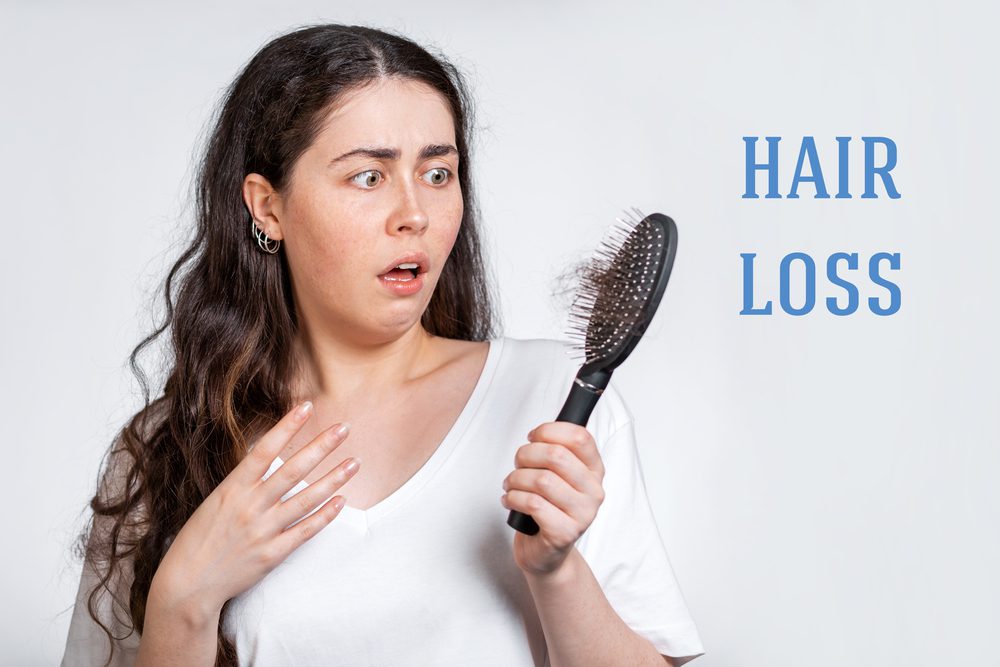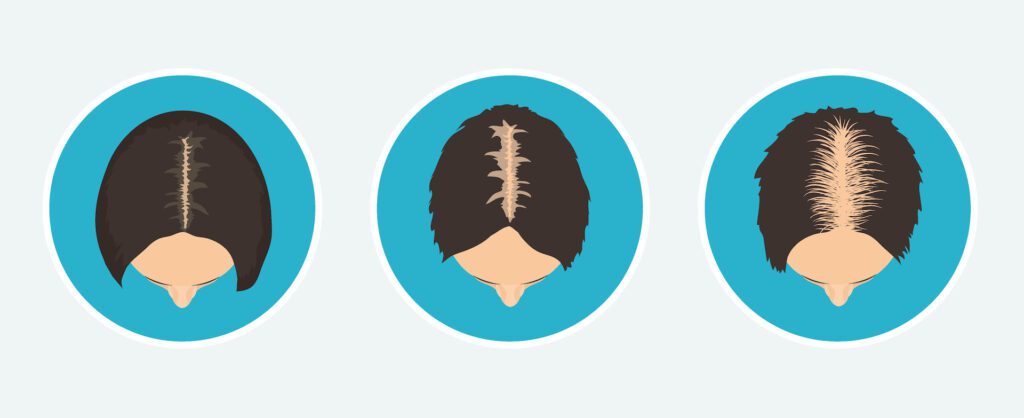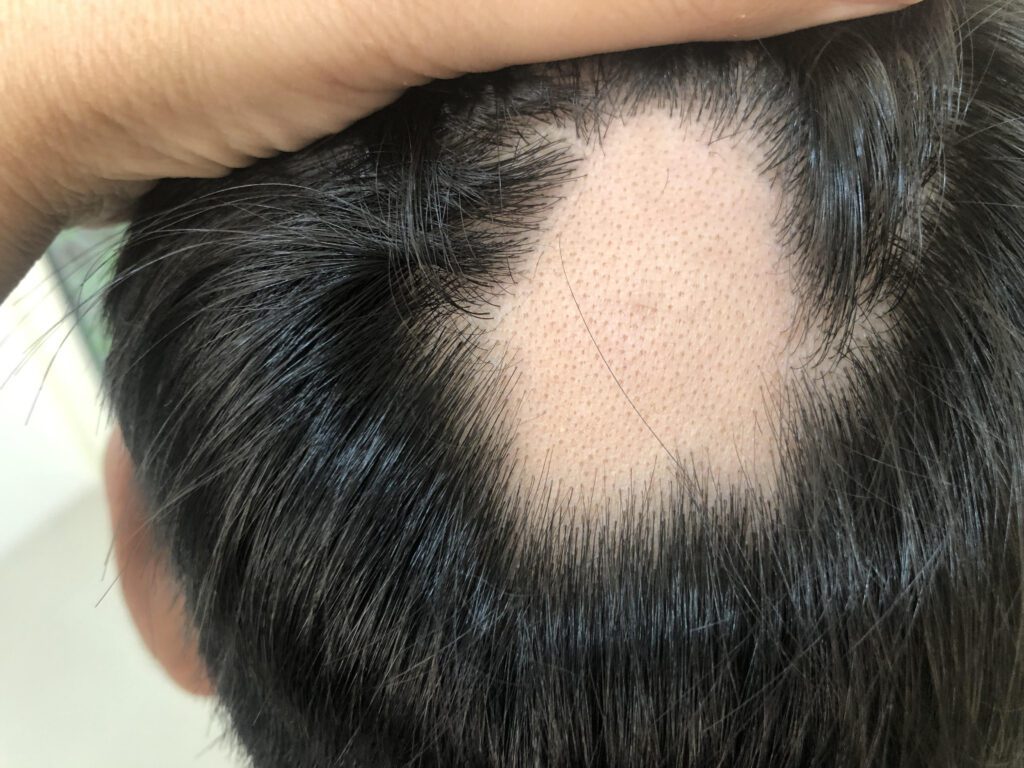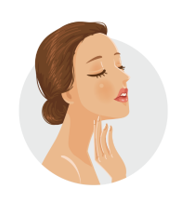Regrow hair naturally in 3 months I Dermatologist Guide
December 11, 2021 2023-07-08 7:51Regrow hair naturally in 3 months I Dermatologist Guide
As an Amazon associate, Dermatocare earns from valid purchase made by clicking on the affiliate links in this blog.

Regrow hair naturally in 3 months I Dermatologist Guide
“Doctor, can I regrow my hair in 3 months naturally?“
Yes you can! Most case of hair loss are reversible, until unless you are too late! Hair takes 3 months to emerge from the hair roots. Therefore 10 day oils or miracle cures are unlikely to work. There is no quicker fix for hair regrowth!
In this article, I am sharing a plan to regrow your hair in 3 months. This approach has worked for thousands of patients at my clinic. Before we embark on the journey of hair re-growth, let us find out if your hair fall is significant.
Is your fall significant?
Hair loss of 100 hairs per day is normal. But, it is very difficult to gauge when this limit of 100 hairs is crossed. Here are 7 warning signs when you should consult your dermatologist:
- Bunch of hair while combing or shampooing your hair.
- Hair on your pillow, bedding or floor.
- Thinning hair strands.
- Visible bald scalp.
- In cases of males, receding of the frontal hairline and broadening of the forehead is the first sign of male pattern hair loss.
- In females, the widening of the central parting and reduction in the ponytail volume are ominous signs.
- Positive hair pull test: Pull approximately 100 hair using moderate pressure. If you get more than six hair, it indicates that you have active hair fall.
Once you know that your hair needs expert care, you must find out what type of hair fall you have.
How do I know my hair loss type?
There are four types of hair loss, and each needs an entirely different approach to management. Therefore, it is crucial to find your hair loss type, for details, with this video.
1. Telogen Effluvium

If you are losing your hair diffusely from all over the scalp without any pattern, then you might have telogen effluvium. It is the most common cause of hair fall in the case of females.
The reason for this kind of hair fall is a lack of proteins, vitamins, and minerals in the diet, hormonal imbalance, stress, medications etc, as discussed in this video.
2. Female pattern hair loss (FPHL)

Female pattern hair loss (FPHL) or Female Androgenetic alopecia is the second most common cause of hair loss in females. In FPHL, there is gradual thinning and shortening of hair, leading to the widening of central parting.
This hair loss is primarily genetic, but a few patients might have underlying hormone imbalances like PCOD. Watch this video for the causes, symptoms and treatment of FPHL:
3. Male pattern hair loss

Suppose your hairline is receding along with thinning of hair along with a history of similar hair loss in your father, maternal or paternal uncles, or grandfather. In that case, you have Male pattern hair loss or androgenetic alopecia(AGA). Unfortunately, it is an irreversible process, and early treatment can prevent the recession of the hairline, as discussed in this video.
4. Patchy hair loss

Scalp diseases like alopecia areata, lichen planus, DLE, etc mostly cause patchy hair loss. Immediate dermatologist consultation is necessary to find the reason for patchy hair loss and stop the progression.
Once you know your hair loss type, the next step is to remove the cause of hair fall.
What causes hair fall?
Based on my experience of treating thousands of patients of hair fall, most patients have multiple reasons for hair fall. Even patients with patterned hair loss might have one of the causes of hair fall listed below:
Acute stress:
Any physical or mental stress that mandates you to take bed rest can result in hair loss. For example, high-grade fevers (typhoid, malaria, etc.), major surgery, severe trauma, bereavement etc. In contrast, a mild covid infection can cause hair loss after three months.
Chronic illness:
Any chronic medical disease like cancers, chronic kidney or liver diseases, tuberculosis etc. can result in hair loss.
Hormonal factors:
Hormones are important in maintaining hair cycle. Hypo/hyperthyroidism, polycystic ovarian diseases (PCOD), discontinuation of oral contraceptive pills and delivery can cause hair loss. The hormonal cause should be suspected in the following situations:
- change in your menstrual cycles
- weight gain
- pimples on the jaw line or near your menses
- thick dark hair on the face
Post-Partum hair loss:
Diffuse hair loss in mother and baby is common 3-6 months post-delivery, and it usually stops in a few months. Typically, scalp hair stays in the growing/anagen phase for 3 years, followed by the dormant/catagen stage for 3 months and is finally shed in the telogen stage. However, during pregnancy, your scalp hair stays in the growing phase and does not enter the dormant and shedding stage. As a result, your hair might appear more voluminous during pregnancy.
But soon after delivery, the usual hair cycle resumes and all the backlog of hair that didn’t enter dormancy suddenly enter into the dormant stage. Since, your hair stays in dormant stage for 3 months before falling, postpartum hair loss generally begins 3 months after delivery.
Dietary deficiencies:
Hair loss can occur if you are not taking enough proteins, vitamins, minerals etc.
Medications:
Your hair loss could be due to medicines for high blood pressure, thyroid disorders, psychiatric diseases, hormonal imbalance etc.
Mental stress:
Normal day stress is unlikely to cause hair loss. Undue stress like bereavement, loss of a job, depression etc. can cause hair fall.
Idiopathic:
In females at the age of 30-60 years, sudden shedding and thinning of hair rarely occurs without any reason. You may have hair shedding all over the scalp, especially the temporal area.
I hope till now you have figured out the type and cause of your hair loss. Now let re-regrow your hair naturally with hair care routine and diet listed in next section.
How to regrow hair in 3 months?
Hair regrowth can be induced by the right hair care products and diet, along with the removal of the cause. Given below is a 4-steps hair care routine to regrow hair.
New hair growth is visible by the first month in mild cases with this hair care routine. But in severe cases, growth might takes three to six months. This hair care routine can be continued until you achieve your average hair density.
Step 1: Hair oil
Hair oil with potent hair regrowth herbs can promote hair regrowth. For best results, you should apply hair oil starting from the hair roots to the tip once or twice a week. In the case of dry hair, the overnight application is best. While in oily hair, you can put oil 2-3 hours before hair wash.
RECOMMENDED BRANDS: Best oil for hair re-growth
Step 2: Shampoo
Hair shampoo removes the build-up and contributes to normal scalp health. Therefore, wash hair as soon as they get oily, dirty or sweaty to avoid build-up.
You might have to wash them daily in case of oily hair or if you work out. While twice or thrice a week is enough for dry hair.
RECOMMENDED BRANDS: Best Shampoo for hair regrowth
Step 3: Apply hair conditioner
After the hair wash, apply hair regrowth conditioner on strands from the level of the ears. Conditioner seals hair strands with a silicone coating. This adds shine and protects the hair.
RECOMMENDED BRANDS: Best conditioner for hair regrowth
Step 4: Redensyl serum to regrow hair
This is the most effective step. Hair regrowth serum that contains biopeptides like Redensyl, Angain, Procapil etc. can grow hair in 3-6 months. These bio-peptide serums should be applied to hair roots twice a day for three months
The correct application is essential. Put 1 ml of serum in the cap of the bottle. Use your fingertips to apply the serum to hair roots. Start from an area with maximum baldness. Do not put the serum on wet or oily hair. Before putting serum, dry your hair with the towel. Put oil after 30 minutes of applying hair serum.
RECOMMENDED BRANDS: Best Redensyl serum
Which is best hair regrowth vitamin?
Most people make mistake of using Biotin for hair growth. There is no scientific evidence for taking biotin for hair loss. studies show that Vitamin D, B12, and Ferritin (Iron stores) deficiency is the most common cause of hair loss.
Therefore, the right hair re-growth vitamin should contain multivitamins, minerals, amino acids and herbs to stimulate hair growth. You might have to consume hair supplements for 3 to 6 months until your hair fall stops.
RECOMMENDED BRANDS: Best supplement for hair regrowth
Which is the best protein powder for hair re-growth?
Many patients with hair loss have a deficiency of proteins, calories and omega-3 fatty acids. If you don’t have time to incorporate elaborate diet suggestions in the next section, then you should take a plant-based protein supplement in addition to a hair-regrowth vitamin.
We do not recommend whey protein supplements to patients with hair loss, especially male and female pattern hair loss. To know why, read this article, Can whey protein cause hair loss?
RECOMMENDED BRANDS OF PROTEIN SUPPLEMENTS:
bGREEN Muscleblaze Vegan Plant Protein Powder
Diet to regrow hair in 3 months:
Eating a diet that promotes hair re-growth is crucial. If you are losing hair despite eating healthy, you must look at your diet closely. You need to hit at least 1800 calories/day in the case of females and 2000 cals/day in males (without workout). If you are on a fat loss diet, then do not aim for more than 2-3 kg weight loss per month.
Besides adequate calories, Proteins are crucial for hair growth. Females need 50 g, and males need 60 g of proteins daily. In addition, you should include fruits, vegetables, nuts and seeds in your diet. For more details, read Diet for good skin and hair.
When should I consult dermatologist?
You should consult dermatologist for hair fall in following scenarios:
- If you have untreated hormonal issues like hypothyroidism or PCOS
- Male and female pattern baldness patient would need Minoxidil instead or serums.
- Severe vitamin deficiencies: If your blood test show deficiency, than consult dermatologist for correction. Multivitamins do not correct deficiencies, they just provide amount of vitamin and minerals needed in a day called as RDA.
What is treatment of hair fall?
You might have to seek dermatologist help in following cases:
- If you have untreated hormonal issues like hypothyroidism or PCOS
- if you have Male and female pattern baldness.
- If your blood test shows a deficiency, consult a dermatologist for correction. Multivitamins do not correct deficiencies. They just provide the amount of vitamins and minerals needed in a day called as RDA.
Your dermatologist might prescribe on of the following:
Minoxidil is the oldest and most effective hair regrowth product. Many patients fear using Minoxidil because of wrong information on the internet. Please read this article to clear all your doubts, Minoxidil Side effects I Dermatologist reveal the truth
Derma-rollers: Derma-roller contains multiple pins that stimulate hair growth and help penetration of Minoxidil lotion when rolled on your scalp.
Meso-therapy: This consists of injecting vitamins and minerals required for growth of hair into your scalp near the hair roots.
Platelet-rich plasma therapy: This is a new technique in which your blood is withdrawn, and the factors which help in hair growth are extracted and injected into hair roots.
Stem cell therapy is still controversial and claims to use factors extracted from stem cells to stimulate hair.
Hair transplant: This procedure has gained rapid popularity in Male pattern baldness.
ROUTINE FINDER
Get free dermatologist-recommended regime by choosing your skin or concerns.

FACE

HAIRS

CHILD

BODY
